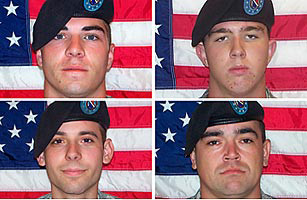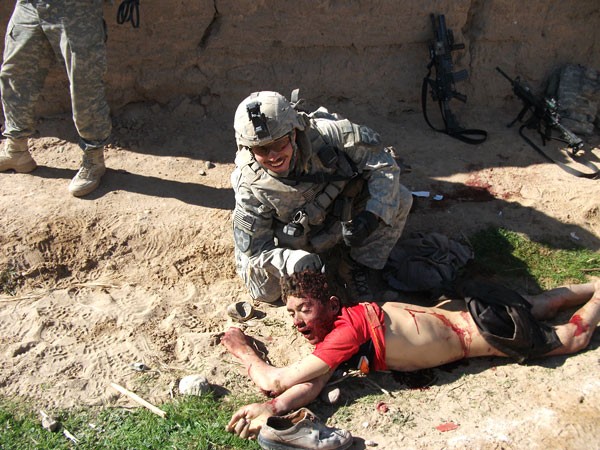By Joanne Laurier

Army Specialist Jeremy Morlock, Private 1st Class Andrew Holmes, Specialist Adam Winfield and Specialist Michael Wagnon are among a dozen infantrymen of the 5th Stryker Brigade, based in Washington state, who are charged in a case stemming from their deployment in Afghanistan's Kandahar province. (Photo: Reuters)
An important documentary, The Kill Team, opened in New York City and Toronto on July 25, and will play in other North American cities over the next several weeks and months. The WSWS reviewed the film as part of our coverage of the 2013 San Francisco International Film Festival. This is a slightly edited version of that comment.
“The constant pressure to kill or be killed. It is impossible not to get into the insanity of it,” explains US army Corporal Jeremy Morlock in a new documentary about a group of American soldiers nicknamed the “Kill Team.”
The moniker, applied by the media to members of an army unit who committed war crimes in Afghanistan, is also the title of the film by US documentarian Dan Krauss.
The platoon came from the Fifth Stryker Brigade, Second Infantry Division, based at Lewis-McChord Army Base near Seattle, Washington. The filmmakers focus on Specialist Adam Winfield, who was 17 at the time he joined the army. Deployed to Afghanistan in July 2009, Winfield was contacting his father Chris by February of the next year about atrocities being committed by members of his unit, whose ringleader and highest-ranking member was Staff Sergeant Calvin Gibbs.
According to the film’s production notes, Krauss came upon an April 27, 2011, story in the New York Times (“A Beast in the Heart of Every Fighting Man” by Luke Mogelson) that described Winfield as both a whistleblower and a murder suspect. The article claimed the designation “Kill Team” came from a leaked video interview in which Winfield told an army special agent that Gibbs “thought I was weak and I’m not good enough to be on his quote-unquote ‘kill team.’”
In a four-month period in 2010, the “Kill Team” carried out three murders of Afghan civilians for sport and kept finger and leg bones, a tooth and a skull as grisly trophies in one of the most widely publicized cases of American criminality in Afghanistan.
The unit was based at FOB Ramrod at Maiwand, in Kandahar Province, southern Afghanistan. Its known victims were Gul Mudin, age 15; Marach Agha, age 22; and Mullah Allah Dad, age 45. US military officials later revealed they believed Marach Agha was deaf or mentally handicapped.
The filmmakers also interview Jeremy Morlock, 21 at the time of the crimes and considered a key participant in the premeditated murder of the civilians. Under the terms of a plea bargain, Morlock’s life sentence was reduced to 24 years and a dishonorable discharge in exchange for his cooperation in the courts martial of other soldiers.
Another principal participant in the movie is Private First Class Andrew Holmes, 19 at the time of the murders. He was charged, along with Morlock, in the January 15, 2010, murder of Gul Mudin and pleaded out for a maximum sentence of seven years.

In a break with protocol, the soldiers also took photographs of themselves celebrating their kill. In the photos, Morlock grins and gives a thumbs-up sign as he poses with Mudin’s body. Note that the boy’s right pinky finger appears to have been severed. Staff Sgt. Calvin Gibbs reportedly used a pair of razor-sharp medic’s shears to cut off the finger, which he presented to Holmes as a trophy for killing his first Afghan. (Photo: Rolling Stone)
More Photos
Gibbs, who was charged with three counts of premeditated murder, was sentenced to life in prison with eligibility for parole in 10 years. His civilian attorney and family refused contact with the filmmakers. Gibbs had already served two tours—one in Iraq and another in Afghanistan. Both Winfield and Morlock characterize him as a sociopath who orchestrated the killings, which were staged to make it look as though the soldiers had come under attack and were therefore involved in legitimate engagements. Gibbs repeatedly referred to the Afghan people as “savages.”
Gibbs may have been the immediate instigator of the crimes and deserves punishment, but he is also something of a scapegoat. The real criminals, responsible for the rivers of blood in Afghanistan and elsewhere, are those who decided on and carried out the policy of aggressive, illegal war. They are to be found in the White House, the Pentagon, Congress and the comfortable offices of America’s leading media outlets.
Many of the film’s interviewees point out that US occupation forces in Afghanistan routinely murder civilians in the course of the neocolonial war obscenely dubbed “Operation Enduring Freedom.”
The actions of the “Kill Team,” in fact, came to light purely by accident. After Private First Class Justin Stoner reported drug use in the platoon to a superior, members of the unit assaulted him. Officers then learned that Gibbs had shown Stoner human fingers to intimidate him, ultimately leading investigators to the murders. Stoner glibly states to the camera that such crimes happen all the time: “We’re just the ones that got caught.” This is one of the truest lines in the film.
Atrocities such as those carried out by the “Kill Team” have long been employed in counterinsurgency operations by the US and other imperialist powers to “pacify” populations that resist occupation, from India to Kenya, Ethiopia to Angola, Algeria to Vietnam. The US military provides the training and weaponry with which its soldiers maim and kill. The drive by the American ruling elite to dominate the globe creates the conditions where individual psychosis and sadism must flourish.
Investigations by Der Spiegel and the Army Times have both suggested that Col. Harry Tunnell, the brigade’s commanding officer, may have created an environment in which rogue soldiers like Gibbs felt sure they could literally get away with murder. (I’m not trying to connect the dots here, but it also sounds like half the soldiers in the brigade got baked on potent Afghan hashish every day while the officers looked away.) But no one higher than Gibbs’ rank was ever charged with anything, and as “The Kill Team” demonstrates, the Army spent significant time and resources on prosecuting the one soldier who actively tried to report Gibbs and the other killers. Winfield’s obvious revulsion at what was happening made him the target of Gibbs and other soldiers, who discussed eliminating him by way of an unfortunate accident in the weight room, or a friendly-fire incident while on patrol.
The Kill Team is a chilling, disturbing work. Through Morlock’s comments in particular—he is one of the most articulate of the soldiers interviewed—the audience gets a glimpse of the psychological collateral damage produced by the military’s “warrior” mentality.
“Death and dead bones. You’re taught it’s the norm to be OK with it,” he says at one point. Morlock further comments: “You go home, nothing’s normal. You go home and you’re angry and pissed off. You have no grasp of your emotions. Who could you tell? You turn inward.”
Stoner makes one of the bluntest statements: “You’re training us from the day we join to the day you’re out [of the army] to kill. Your job is to kill… Your job is to kill everything that’s in your way. Well, then why the hell are you pissed off when we do it?”
The stoic countenances of Morlock, Holmes and Stoner—all very young men—convey a state of disassociation from their crimes. What kind of life awaits them in or outside of prison?
And what kind of life awaits hundreds of thousands of other veterans of America’s neocolonial wars, physically or psychically mutilated? The American political and media establishment, from Barack Obama on down, is entirely indifferent to the disaster it is producing.
Much of the film is spent in the company of Adam Winfield’s parents, Chris and Emma, from Cape Coral, Florida. Their faces register some of the horror of the events and the suffering those have caused.
After Adam sent a text to his father saying that “they’re killing people here... I want to do something about it... I don’t feel safe,” Chris Winfield phoned the army inspector general’s hotline, the office of Senator Bill Nelson (D-Fla.) and a sergeant at Joint Base Lewis-McChord, who told him to contact the army’s Criminal Investigation Division. Although a sergeant at the Fort Lewis command center agreed with Chris Winfield that his son Adam was in danger, he said that Adam had to report the crime to his superiors before the army could take action.
While in Afghanistan, Adam repeatedly told his parents he feared for his life. Says Chris: “The Army wants to make this go away...no officers are charged. If Adam had gone [to his superiors] in Afghanistan he would be dead.” Morlock confirms that Gibbs told him, “Winfield is a liability...we have to take this guy out.”
On May 2, 2010, the “Kill Team” decided to carry out another murder, forcing Adam to be present and thus complicit. Regretting that he succumbed to the pressure, Winfield explains: “I had a responsibility to stop what was going on.” He is the only one of the soldiers who expresses remorse over the murder of innocent civilians. The film implies that the military punishes soldiers who bring to light its institutional crimes.
Adam accepted a plea agreement carrying a charge of involuntary manslaughter for failing to stop his fellow soldiers from killing Allah Dad. The judge sentenced him to three years and a bad conduct discharge. He is now out of prison.
Winfield tells the camera: “War is dirty. [It’s] not how they portray it in the movies.”
In the movie’s production notes, the director states: “Adam Winfield was forced to confront his core morality in the blink of an eye, amid the most unimaginable circumstances. These sorts of life and death decisions are incredibly destructive—not just at that moment—but in the months and years afterward, as soldiers replay in their minds over and over again the choices they made or failed to make.” In an interview, Krauss remarked, “To actually hear soldiers talk…and delineate these decisions in all their complexity is very troubling.”
This moral destruction is the inevitable outcome of a conflict that is but one chapter in the never-ending brutality known as the “war on terror.” The Kill Team makes clear that the unit was not some rogue outfit, but conducting itself according to the US military’s standard operating procedures.



